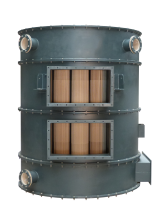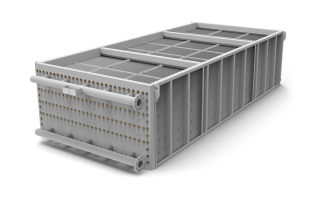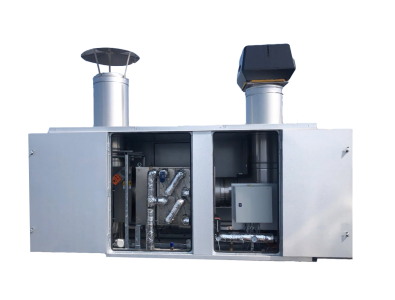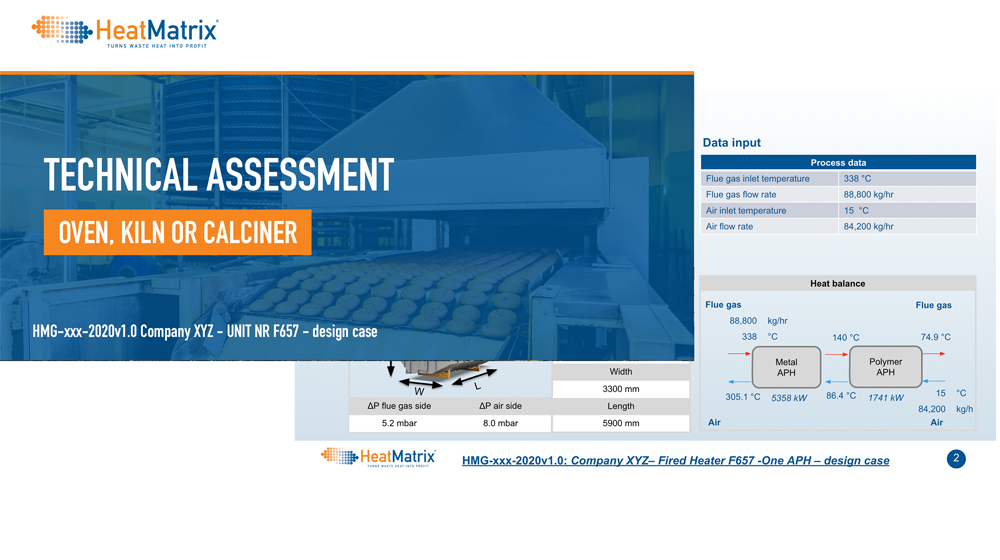Waste heat recovery from Industrial Ovens, Kilns & Calciners
Corrosion and fouling limit heat recovery. Polymer economisers and air preheaters are corrosion resistant and fouling can be easily cleaned.
Your Oven, Kiln or Calciner has additional waste heat recovery potential

Improve oven efficiency
The oven efficiency can be improved by using a polymer air preheater or economiser.
Lower CO2 emissions
Every 1% efficiency increase of your Oven, Kiln or Calciner results in 1% CO2 emission reduction.
Decrease fuel costs
The additional heat that is recovered is applied to heat up air entering the oven or heating up process water. Therefore, fuel consumption is reduced.
Waste heat recovery on Industrial Ovens, Kilns & Calciners is limited by corrosion and mechanical failures
Waste heat is lost via the stack
The required heat in Ovens, Kilns or Calciners is generated by firing fuels like natural gas, hydrogen rich gas, fuel oil. The heat loss can be significant. Recovering this heat can be challenging due to the fouling and sometimes corrosive character of the exhaust air, product vapours and flue gas.
Corrosion and fouling problems
Hot exhaust air and flue gas from Ovens, Kilns or Calciners are vented into the atmosphere. The exhaust air or flue gas may contain: combustion products from the fuel, components released from the processed products and dust particles. In general, the exhaust air and flue gas tend to be fouling and/or corrosive due to the components present. When the flue gas is cooled to recover heat, the acids will condensate and fouling accumulates.
How to recover more waste heat from your Oven, Kiln or Calciner
Use flue gas heat to warm up water
The first and most important question to answer is what to do with the recovered heat. Heating up water is one of the options. The hot water can be used as process water or water for cleaning purposes. The hot water can also serve as an energy carrier for heating buildings or to export the heat to neighbours. To prevent corrosion and deal with fouling, a polymer or stainless steel Economiser – which is corrosion resistant and has good anti-fouling properties – is applied.
Use flue gas heat to warm up air
A second way to improve the efficiency of your oven, kiln or calciner is by heating up combustion air or warming up oven circulation air. The hot air can also be exported for drying purposes. To prevent corrosion and deal with fouling, a polymer air preheater – which is corrosion resistant and has good anti fouling properties – is applied.
In-line cleaning
All HeatMatrix heat exchangers can be equipped with an in-line cleaning system. This prevents blocking of your heat recovery system. Water or other cleaning liquids can be used. Condensate and washing liquids are collected separately and can not flow back to your process.
Waste heat recovery systems for Ovens, Kilns and Calciners

Polymer Air Preheater

Stainless steel or Polymer Economiser

EcoPack
In the EcoPack the exhaust air or flue gas heat is recovered to warm up water. The EcoPack is a complete installed solution for smaller flows. You can directly start saving energy.
Industrial Cookie Bakery
20% gas reduction
The industrial bakery has the ambition to reduce energy consumption. In the production process of cookies many fatty ingredients are used like butter and chocolate. In the oven fouling baking vapours are extracted and currently released to the atmosphere at high temperature. The bakery would like to recover heat from these vapours to reduce overall energy consumption.
Because of the smooth surface of the polymer tubes the HeatMatrix polymer air preheater has a low tendency to foul. This aspect in combination with an in-situ cleaning system made it the perfect combination for heat recovery at this bakery.
A polymer air preheater was installed and cools down all the baking vapours from the oven. Circulation air for the oven is preheated from 15 to 103°C, which results in a heat recovery of 143 kW and a reduction of the oven gas consumption of 20%.
Case study Brick manufacturer
591 kW heat recovered
In the ceramics industry flue gases are released from the oven at a temperature of 150 to 250 °C. This flue gas is sent directly to the atmosphere and a significant amount of energy is lost. Main reason for not recovering heat from this flue gas is the presence of sulphur oxides, chlorides, fluorides, soot and dust. When the flue gas is cooled down, an acidic condensate is formed which causes corrosion.
The polymer air preheater of HeatMatrix is a robust solution for the corrosive and fouling flue gases. The inline cleaning system allows frequent water washing which ensures an optimal performance of the air preheater at all times. The air preheater is insensitive for corrosion due to the used polymers. The recovered heat is typically used to heat-up the air going to the drying chambers.
The HeatMatrix polymer air preheater is able to handle both corrosion and fouling aspects of the flue gas. The installed cleaning system in combination with the smooth surface of the polymer makes it possible to clean the heat exchanger within 3 minutes in case particles or dust have accumulated. A business case was prepared to use the recovered heat for preheating of the incoming cold air at the dryer section. A overall payback period of 3 years was determined.
Technical Assessment of heat recovery on your Oven, Kiln or Calciner
- Analysis of process data of your oven, kiln or calciner
- Minimal input data required
- Business case on your savings potential

FAQ's about Industrial ovens
How does an Industrial oven work?
An industrial oven is used for many purposes like baking bread, curing products or ceramics production. Temperatures in ovens can range from 200ºC in food applications to 1100ºC during ceramics production. An industrial oven can be a batch type or continuous type like a tunnel oven. The required heating is can be done either with burners inside the oven -called direct firing- or with a separation between flue gas and the oven, called indirect firing. Typically, natural gas is used as a fuel but other fuels can be used as well.
How does waste heat recovery on an Industrial oven work?
The flue gases released from an industrial oven have a high temperature and represent a substantial energy loss. By applying flue gas heat exchangers this heat can be recovered and reused for heating (combustion) air, buildings, process water, CIP water, thermal oil or hot water for an external heating grid.
Benefits of waste heat recovery on Industrial ovens?
Recovery of waste heat from an industrial oven prevents loss of valuable energy. Integration of the recovered heat in the process reduces the overall fuel consumption and leads to savings in CO2 emission and fuel costs.
FAQ's about Kilns
How does a Kiln work?
A kiln is used for, amongst others, ceramics production. An industrial kiln can be a batch type or continuous type like a tunnel kiln. The required heating is typically done with burners inside the kiln. The flue gases are in direct contact with the product in the kiln. Different type of fuels can be used for firing like natural gas and fuel oil.
How does waste heat recovery on a Kiln work?
Substantial energy losses occur at Kilns because the flue gases still have a high temperature. This heat can be recovered with flue gas heat exchangers. The recovered heat can be reused to heat (combustion) air, process or boiler feed water, thermal oil or or hot water for an external heating grid.
Benefits of waste heat recovery on Kilns?
The loss of valuable energy from kilns can be prevented with waste heat recovery. The overall fuel consumption is reduced with this recovered heat. This leads to savings in CO2 emissions and fuel costs.
FAQ's about Calciners
How does a Calciner work?
A calciner is used in the chemical industry to calcine products. The calciner can be both a batch and continuous process which takes place at temperatures that go up to 600ºC. The required heating is typically done with burners inside the calciner. The flue gases are in direct contact with the product in the calciner. Different type of fuels can be used for firing like natural gas and fuel oil
How does waste heat recovery on a Calciner work?
In calciners flue gases with high temperature are released which results in a substantial energy loss. With a flue gas heat exchanger the heat can be recovered and reused for heating (combustion) air, process or boiler feed water, thermal oil or or hot water for an external heating grid.
Benefits of waste heat recovery on Calciners?
Waste heat recovery from calciners prevents the loss of valuable energy. The recovered heat is integrated in the process to reduce overall fuel consumption, CO2 emissions and costs
